by Gavin Finlay
The American Civil War of 1861-65 is one of modern history’s most catastrophic conflicts. With approximately 750,000 fatalities and 400,000 wounded, it remains the deadliest war in US history. Yet relatively little is known in Ireland, or indeed officially recognised here, in this the sesquicentennial of the war, that it was also arguably one of the most significant conflicts in Irish history. Over 1.6 million Irish people lived in the United States by the 1860s and approximately 170,000 Irish-born men fought, and perhaps tens of thousands died, during the conflict (the vast majority for the Union). These figures almost mirror the numbers of Irish who fought in World War I. In other words, the American Civil War represents the second largest deployment of armed manpower in the history of Irish militarism. Indeed, recently it has been described as Ireland “great forgotten conflict”. The Irish experience in the American Civil War is a popular theme amongst American historians, and the Irish-American community in general, where it continues to be studied and commemorated across the Atlantic.
In the coming decade of commemoration, the Irish state will, and rightly so, remember those who participated in the calamitous and tragic 1914-18 war (and of course the revolutionary 1916-23 period). While recent commemorative gestures have been welcome, such as the Irish Defence Forces partaking in the 150th anniversary of the Battle of Fredericksburg last December, there is still no official memorial to the tens of thousands of Irish emigrants who perished in the American Civil War. In this year of The Gathering, when we reach out to the global Irish diaspora, perhaps a proper acknowledgement of Irish who fought in America’s defining conflict is long overdue.
The National Library of Ireland has a number of documents, as well as dozens of books and memoirs, on Irish participation in the American Civil War that will interest any scholar or enthusiast of this fascinating period of (Irish) American history. What follows is a focus on just one set of documents the library has in its possession...
Listed as Ms. 18,327 are papers in the NLI's manuscipt collections relating to John O’Neill, originally of Portarlington, Co. Laois, who served in the Federal Army during the American Civil War, and who died in Andersonville, Georgia in 1864. The letters and documents date between c.1860-1880s, and include some correspondence between John and his family in Portarlington. Most fascinating is a detailed and protracted correspondence between John's mother, Dora O’Neill (and her legal representatives) and the US War Department, War Pension Agency, Sanitary Commission and US Treasury in Washington regarding her claim for a dependent's war pension for her “missing presumed dead son”. Dora was ultimately successful.
In this letter, Private O’Neill writes to his mother in May 1964 during the Battle of Spotsylvania Court House in Virginia. This battle was the second major battle of Lt. Gen. Ulysses Grant’s Overland Campaign and in total involved around 100,000 Union forces and 52,000 Confederates. The resulting casualty toll of 32,000 makes the Battle of Spotsylvania one of the top five deadliest battles of the Civil War.
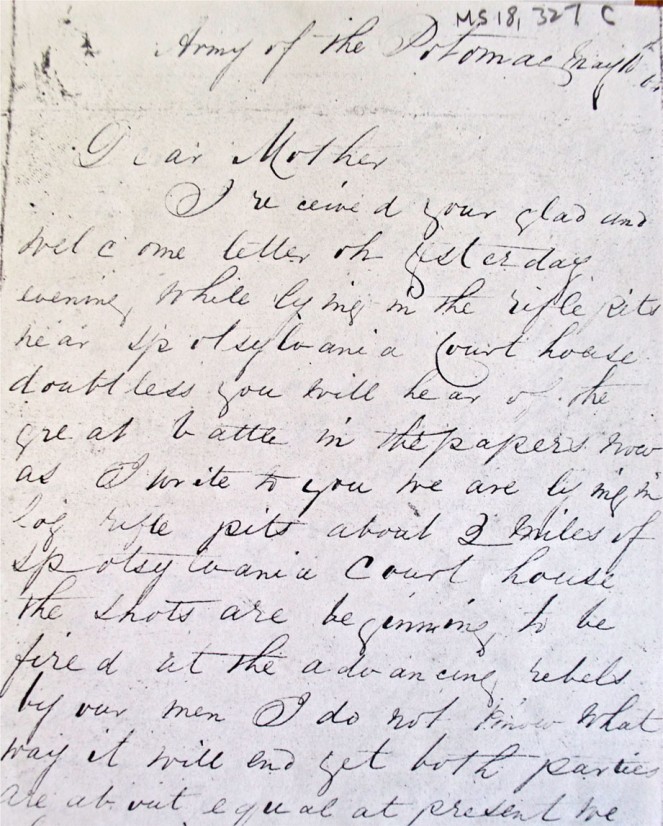
Letter from John O'Neill, Army of the Potomac, to his mother on 10 May 1864. NLI ref. Ms. 18,327
“Doubtless you will hear of the great battle in the papers”, he writes. “Now as I write to you we are ... in the rifle pits about two miles from Spotyslvania Court House; the shots are beginning to be fired at the advancing rebels by our men. I do not know what way it will end yet, both parties are equal at present...”
Concerned for her son, Mrs O'Neill wrote to the US War Department on 12 September 1864. In the response from Washington below, Mrs O’Neill is informed that “Private John O’Neill of Co. 26 30th Regiment New York Volunteers, appears from the latest information received at this office, (dated August 31, 1864) to be as follows: “Missing in action, supposed to be a prisoner”.”
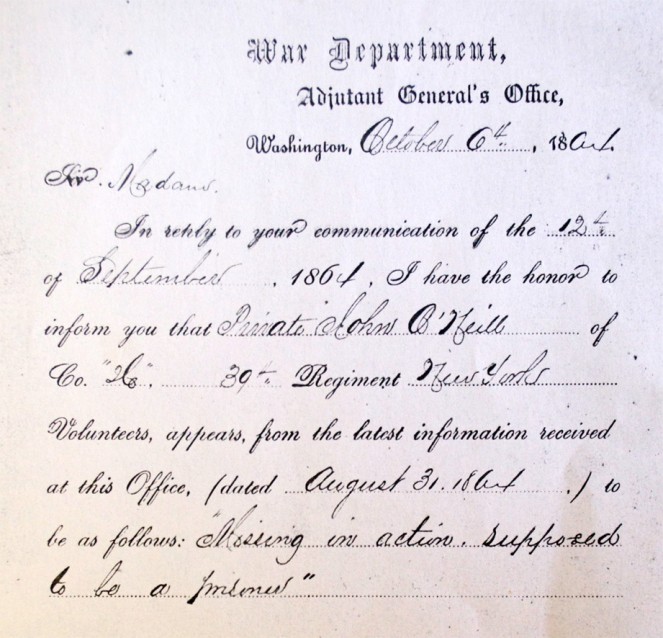
From Assistant Adjutant General at the War Department in Washington to Mrs Dora O'Neill on 6 October 1864. NLI ref. Ms. 18,327
There was very little comfort for Dora O'Neill at the start of 1865 in a communication from John Bowne, Superintendent Hospital Directory in Washington, D.C. Her son John is still taken as missing and "is supposed to be a Prisoner of War".
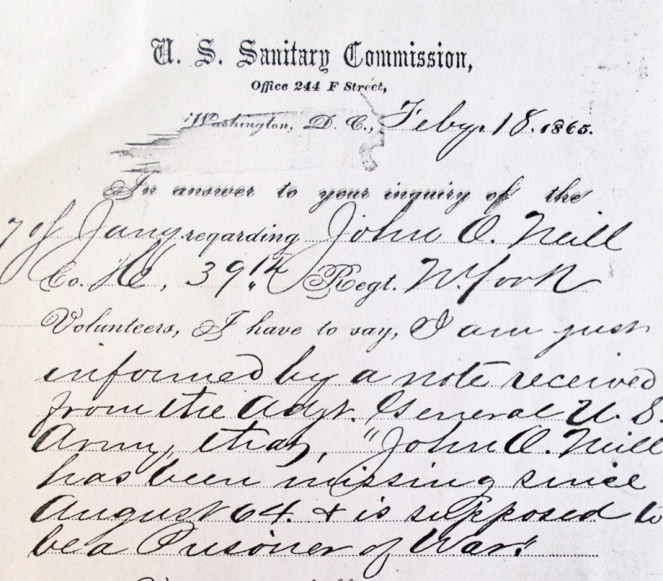
Letter from the U.S. Sanitary Commission to Mrs Dora O'Neill, February 1865. NLI ref. Ms. 18,327
More than twenty years after the war, Mrs Dora O’Neill received correspondence from the Bureau of Pensions enclosing a Certificate (No. 251.154) for a pension “this day issued in your favor”. She is told that when she returns the “properly prepared vouchers” to a recognized attorney in the US, she will be sent a check for the “pension then due”. For his trouble, the recognized attorney who was based in Winsted, Connecticut, was to receive $25.
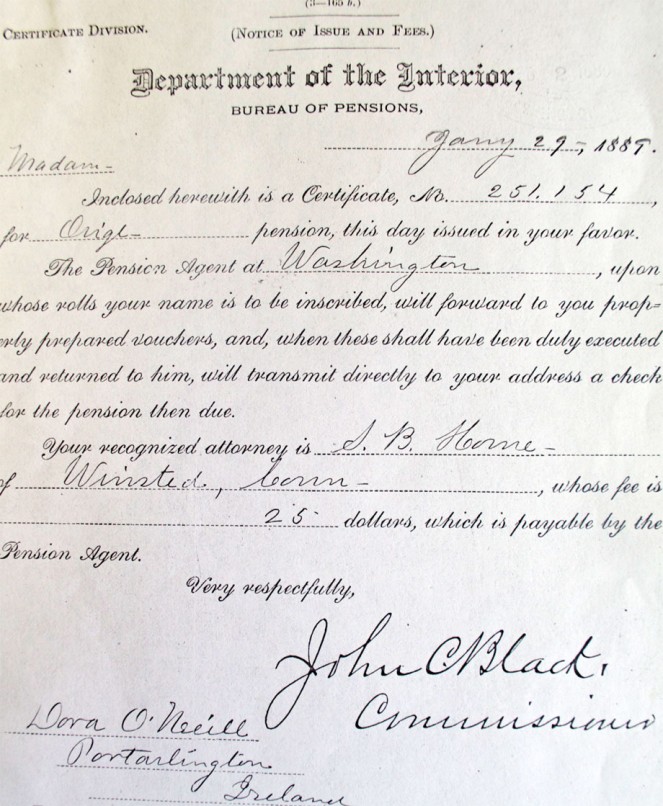
From the U.S. Bureau of Pensions to Mrs Dora O'Neill, January 1889. NLI ref. Ms. 18,327
A document from the office of Sidney L. Willson of the US Pension Agency, For Payment of Pensions in Washington, D.C., enclosed the O’Neill’s original pension certificate and instructions. It is noted that the pension will be payable quarterly, on the fourth day of March, June, September and December.
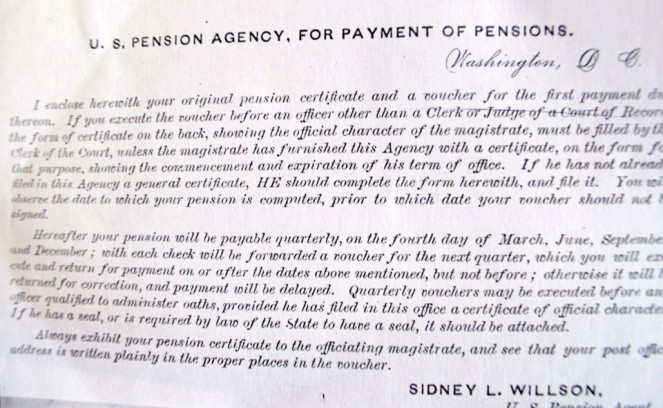
From US Pension Agency. NLI ref. Ms. 18,327
More than 20 years after the O'Neill family of Portarlington, Co. Laois started their campaign to receive a pension following the death of John O'Neill, soldier in the Union Army, at Andersonville, Georgia in 1864, we see this memo from Goodbody and Webb, Stockbrokers of Dame Street in Dublin. Dated April 1889, it confirms an accompanying cheque for £492 14s 2d "being proceeds of American draft $2419.4. We have allowed you 48 [and] 7/8 d per dollar."
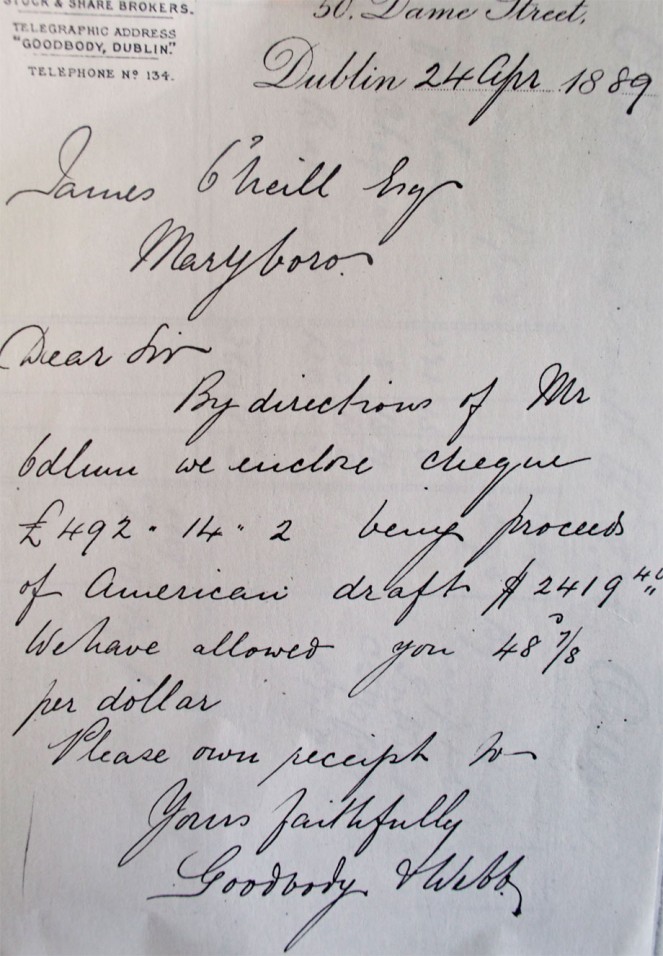
From Goodbody & Webb on Dame Street, Dublin, April 1889. NLI ref. Ms. 18,327
If you have any information about John O'Neill, we'd love to hear it...
(Gavin Finlay is an M.Phil Public History graduate of Trinity College Dublin. As part of the M.Phil programme he completed a short research internship here at the National Library of Ireland. An article based on his research on Irish experience in in the American Civil War will be published in History Ireland later in 2013. He works for Historical Walking Tours of Dublin.)
